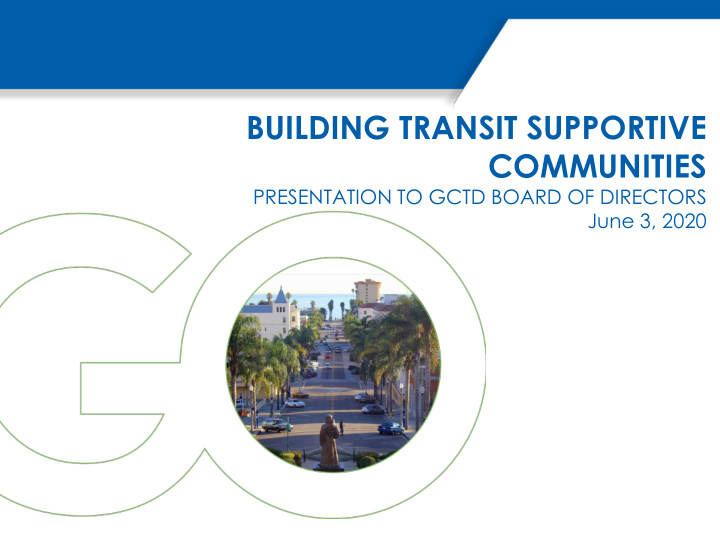



BUILDING TRANSIT SUPPORTIVE COMMUNITIES PRESENTATION TO GCTD BOARD OF DIRECTORS June 3, 2020
PROJECT PURPOSE & GOALS • Share GCTD’s mission and services with partner organizations • Engage with jurisdictions, stakeholders, and developers around land use decisions • Develop planning tools to enhance transit supportive land use and design • Show VMT/GHG reduction possibilities of transit supportive land use and development
PROJECT PROCESS Two community workshops • identified focus areas and prioritized strategies – Local planners, municipal staff, architects, developers, non-profit leaders, and community advocates Workshop materials will • educate additional communities about key components and strategies
GCTD’S CHALLENGES TO BUILDING TRANSIT–SUPPORTIVE COMMUNITIES • People must complete the first and last leg of their trip to and from a transit station on their own. • Even when the physical distance is short, issues of comfort and safety make a difference. • Transit agencies (usually) do not control right-of-way or land use .
SOLUTIONS FOR TRANSIT & LAND USE Why multi-agency coordination on this issue matters: • Efficient use of land and natural resources • Increased transit ridership • Improved air quality - lower GHGs • Positive economic development • Attraction of private investment • Safer streets for all users • Stronger sense of community
LAND USE ANALYSIS GENERAL RECOMMENDATIONS Evaluate Barriers to High Density Residential Development Assess Relationship Between Employment and High Transit Ridership Assess Relationship Between Lower Density Residential and High Transit Ridership Ensure Non-Residential Land Uses Allow For Broad Mix of Uses
STATISTICAL ANALYSIS RESULTS • Independent variables correlating with ridership included: – Amount of Intersections (Importance of Intersection-Dense Stop Areas Pictured) – Population (Including Zero-Car, 65+, Disabled, and Minority) – Job Density – Presence of Medium- Density Residential Zone – Parking Regulations
CATEGORIES OF STRATEGIES • Connected Streets • Managed Curbsides • Residential Density • Job Density
CONNECTED STREETS Protected facilities for people bicycling Sidewalk/crosswalk infrastructure • • investments Active ground floors along corridors New public spaces at intersections • •
MANAGED CURBSIDES Flexible multi-use curb zones Target parking utilization rates • • REPLACE Street closure events and programs Micromobility programs (bike and scooter share) • •
MANAGED CURBSIDES Curbside extensions for bus stops Curbside extensions for parklets • •
RESIDENTIAL DENSITY Eliminate/reduce minimum parking requirements • • Commuter benefits for tenants Increase height limits on transit corridors • Affordable housing on transit corridors • REPLACE 12
JOB DENSITY Flexibility in allowed commercial uses Commuter benefits for employees • • Advocate for Business Improvement • Financing/retention for grocery stores, • Districts / Transportation Management community banks, and/or small businesses Associations 13
Questions?
Recommend
More recommend